Step-by-Step Guide to Integrating VoP APIs in Banking Systems

Step-by-Step Guide to Integrating VoP APIs in Banking Systems
For banks and payment providers in Germany, Austria, and Switzerland, integrating Verification of Payee (VoP) APIs is no longer a “future project” — it’s a must. With SEPA Instant Payment Regulation and PSD2 enforcement tightening, VoP offers more than compliance: it protects against fraud, improves operational speed, and builds customer confidence in every transaction.
This guide outlines a clear, step-by-step approach to VoP API integration, designed for real-world banking systems and DACH-region requirements.
Why Integrate VoP APIs?
VoP APIs validate that the account name matches the IBAN — before the payment goes out. That means fewer errors, fewer fraud cases, and faster resolution when things go wrong.
Key benefits include:
- Fraud reduction: Catch mismatches early and stop APP fraud before it starts.
- Compliance by design: Aligns with SEPA, PSD2, and EPC Rulebook expectations.
- Operational efficiency: Less manual review, fewer disputes, and cleaner audit trails.
- Better customer experience: Fewer failed transfers = more trust in your platform.
In a region where cross-border SEPA flows are daily routine, these aren’t “nice-to-haves” — they’re essential.
Step 1: Audit Your Current Payment Infrastructure
Start by understanding where you stand.
- Can your core banking system integrate with RESTful APIs?
- Where do IBANs and account names enter and flow through the system?
- Are your existing controls enough to meet SEPA’s real-time validation rules?
Document your architecture, data flow, and validation gaps. This sets the foundation for a successful implementation.
Step 2: Select the Right VoP Provider
This isn’t just a tech decision — it’s a strategic one. The right partner should offer:
- High-speed validation: Sub-second matching, even at peak volumes.
- Built-in compliance: Conforms to SEPA IP, PSD2, and GDPR.
- Enterprise-grade security: Data encryption, access controls, and secure logging.
- Flexible architecture: REST APIs, webhook support, file-based options.
And of course — responsive support. Because VoP is mission-critical.
Step 3: Build an Integration Plan
Rushing implementation leads to bottlenecks. Build a structured rollout plan:
- Define goals: Are you prioritizing fraud reduction? Compliance? Reducing manual work?
- Assemble your team: Include IT, risk, compliance, and ops — this isn’t just an “API task.”
- Create a realistic timeline: Plan for sandbox testing, internal review, and production cutover.
- Coordinate with your provider: Align on formats, endpoints, auth protocols, and fallback flows.
Step 4: Test in Sandbox Before You Go Live
Use the test environment to validate everything — not just that the API responds.
- Test matching logic: Does the system return the expected match or mismatch on edge cases?
- Validate error handling: What happens when the name is incomplete, or the IBAN is mistyped?
- Run performance tests: Simulate peak-hour volumes to test response time and stability.
- Check integration points: Make sure VoP fits into the overall payment approval chain.
Only after you’re confident in accuracy and performance, move to production.
Step 5: Secure the Implementation
VoP touches sensitive data — it must be protected.
- Encrypt all traffic and payloads
- Implement access controls to ensure only authorized systems and users can call the API
- Log and monitor all API calls for auditability and incident response
- Stay audit-ready: Ensure your implementation is aligned with SEPA, PSD2, and EPC Rulebook requirements
Step 6: Train Your Teams and Update Customer Messaging
Tech alone won’t deliver the value — people need to understand it.
- Internal training: Show operations, support, and fraud teams how VoP works, what it flags, and what to do when it triggers.
- Customer comms: Explain what’s changing and why — “secure payee validation” improves transparency and builds trust in your brand.
Step 7: Monitor, Refine, and Scale
Once live, don’t just walk away. Monitor performance:
- Review mismatches and error trends: Spot recurring issues and refine your logic or data inputs.
- Watch volumes and latency: Ensure the system can handle load as adoption grows.
- Update rules as needed: Fraud tactics evolve — your VoP strategy should too.
Case Study: VoP Integration at a Leading German Bank
One Tier-1 German bank processing over €1 billion annually adopted VoP for SEPA compliance and fraud reduction.
Results after 6 months:
- 80% drop in APP fraud attempts
- 50% fewer payment disputes
- 30% reduction in manual reconciliation workload
That’s not theoretical ROI — that’s real-world impact.
Why VoP APIs Are a Smart Move for DACH Banks
Integrating VoP means:
- Meeting EU compliance deadlines with confidence
- Catching fraud earlier, before funds move
- Lowering operational costs tied to failed or misdirected payments
- Reinforcing customer trust in real-time payment channels
How Checkpayee Supports Your Integration
Checkpayee helps banks and PSPs in the DACH region implement VoP fast — and with confidence.
- Live in 2–4 weeks
- Full compliance with SEPA IP, PSD2, and GDPR
- Scalable API built for high-volume, low-latency environments
Integrating VoP isn’t just about ticking a regulatory box. It’s about building a secure, efficient, and trusted payment system that can grow with your business.
Book a free consultation to learn how Checkpayee can accelerate your VoP implementation.